The Gift of South Dakota
Subscriptions to South Dakota Magazine make great gifts!
Subscribe today — 1 year (6 issues) is just $29!
Backpacking Sage Creek
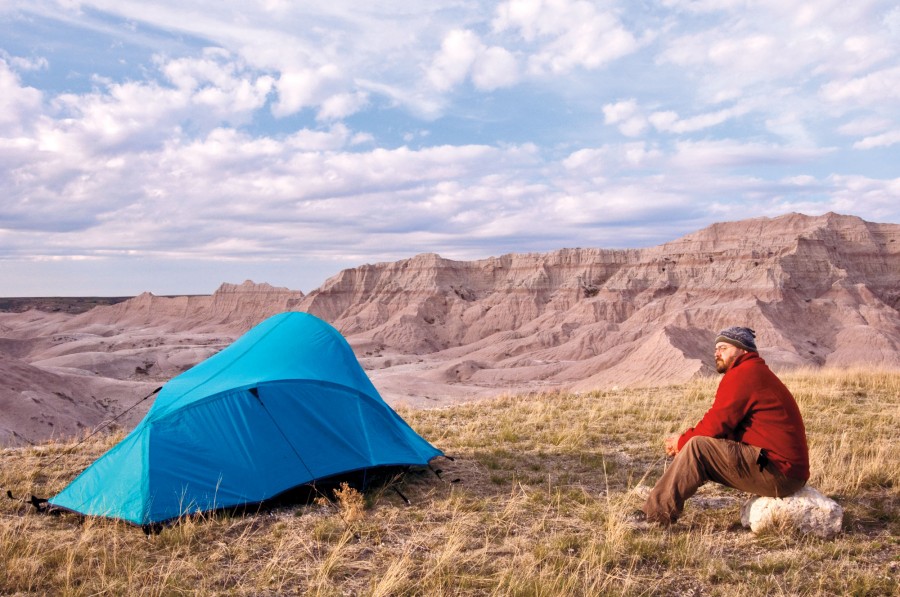 |
| Photographer Carl Johnson traversed the Badlands for three days without a human encounter. |
Badlands National Park is a pleasant, scenic loop away from fast-paced Interstate 90 in South Dakota. Most visitors enjoy short hikes among the formations or fossils on designated trails in the Cedar Pass area. But, unknown to many, the Badlands also offers a superb backpacking opportunity in Sage Creek Wilderness. During Carl Johnson’s month-long visit photographing the park as an artist-in-residence he took a three-day trip to explore the area. Here are excerpts from his field journal.
May 1
There is no designated trail system in the Sage Creek Wilderness; you merely need a compass, a map, and a desire to explore. At 11 a.m., I started at the Deer Haven check-in point, just behind the picnic area on the Conata Road. Deer Haven is a ledge of grass and thick juniper above the main floor of the Conata Basin. I decided to go through rather than around Deer Haven, so I checked the contour lines on my map and surveyed the land for the best way up. Each time I found myself traversing areas with abundant mule deer tracks. I followed them because I figured they knew the terrain better. Their trail led me to a clay scree field, where I crawled up about 10 feet on all fours.
Once over the top, I headed west. There were a lot of drainages coming down through the Sage Creek area, all flowing where I wanted to go, essentially forming the beginning of Sage Creek. Again, I noticed game trails, now a mixture of mule deer, bison and bighorn. To find the best way through the drainages, I followed the trails. Without fail, every time I needed to cross a drainage, creek or gorge, the game trail provided the easiest path. Where I had to cross an active stream, the game trail always led through the shallowest point.
I stopped for lunch atop a small hill adorned with interesting formations, some of which looked like pyramids made of volcanic ash. I had my first bison encounter as I photographed what looked like a crumbling wall from an old city, a geological formation called a clastic dike. The bison stared at me, and I talked to him, letting him know that I was just passing through and wouldn’t bother him. After leaving him I saw something new — several scattered rock beds of quartz and sedimentary rocks. I encountered another bison as I entered greener areas, closer to where I wanted to pitch my tent for the evening. I finally selected a spot, about six miles from where I started, on the edge of some rock beds. The sky was getting cloudy and the wind had picked up. I made dinner, eager to have a hot meal and hoping the weather would change. It was still cloudy when I finished dinner, so I waited inside the tent, taking notes on the day’s trip. The sky opened just before sunset. I worked furiously with my camera, and then retired to read my book.
May 2
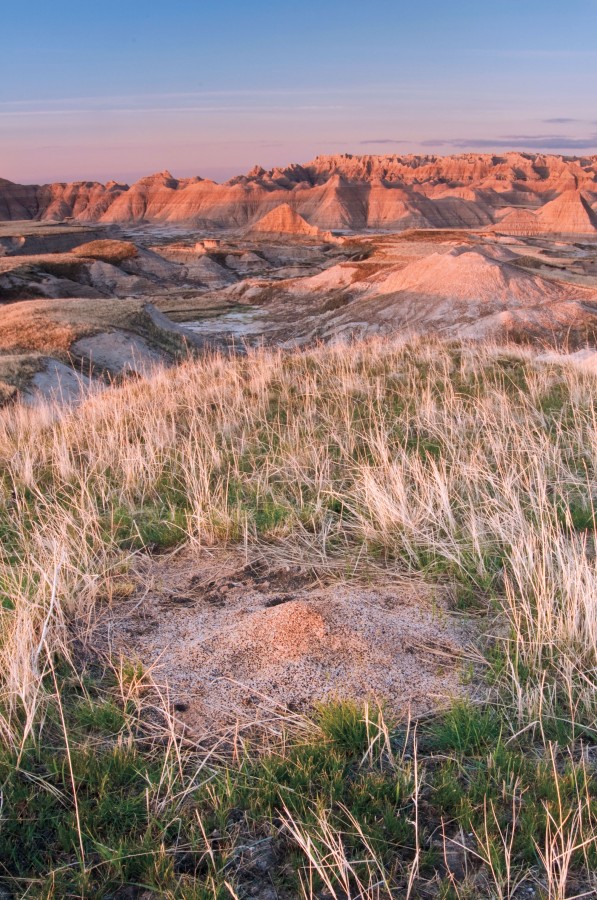 |
| Johnson's journal describes a day's changing light as the sun rises and moves across the Badlands sky: "It washed across the landscape like a painter's brush, selecting pastels to adorn the scene." |
When I arose at 5 a.m., the skies had cleared and there was a spirited exchange of howls and yips from coyotes to the west. I grabbed my camera gear and headed to a small hill I identified the previous day as a good spot to catch the morning light. In the distance, I spied three bull bison sitting on the same grass ledge where I saw them yesterday. There was another large bull about a half mile to the west — grazing in the middle of my planned path. Just before the sun crested, I saw a pink glow on the ridges and formations to the south. As the light climbed, it washed across the landscape like a painter’s brush, selecting pastels to adorn the scene. I kept working with the light until its magical golden hue disappeared, then I went back to camp, made breakfast and was on the trail by 7:50.
Fortunately, the large bull was no longer on my path, and I found myself meandering along a landscape shaped by drainages and a creek that frequently changes course. Eventually I left grassy mesas and a stark, white clay terrain, littered with rock piles and slides, washed and wiped over the centuries by flash flooding. Bizarre pedestal formations popped up intermittently, a reminder of the strangeness of this place.
I finally got around the end of an east-west formation I had paralleled all day and worked my way southwest. I found myself in the middle of what appeared to be the bison freeway. Sets of heavily traveled trails, exhibiting tracks from hundreds of animals, littered this gumbo clay area. By 1 p.m., I found a flat, grassy table — almost a small mesa — about 30 feet wide, 60 feet long, and 50 feet high. Even though it was early, I had found a good spot and did not feel like hiking in the heat. I set up camp, took off my boots and crawled inside my tent.
I loved the rocks on that table. There were several large and unusual boulders covered with a variety of lichens, predominantly a vivid orange. As the evening concluded, I played the same song and dance with the skies. From hot, sunny and clear, it had turned cool and windy with thick, scattered clouds. I worked with those clouds and found some breaks of sunlight to photograph the landscape. I retired my camera for the evening and went inside to read. Sleep came as I lay there, completely alone in this broad landscape, listening to the soft sounds of the winds, accented by the occasional yip or howl of a coyote.
May 3
Realizing that light would not hit as early here as yesterday, I slept in until 5:15 a.m., and made breakfast while waiting for sunrise. Again, it was a clear morning with nary a sign of clouds, and I enjoyed the rare opportunity for solitude in a majestic setting.
By 7:05, I was on the trail toward Sage Creek Campground. Within a mile of my final destination, I stopped for a drink. Soon I realized that I was looking upon a large prairie dog town. What clued me in was the cacophony of back and forth chattering among the mounds. After my snack, I passed through the town and noticed that one prairie dog must have picked a bad time to come out of his hole — bones were scattered around one of the openings. I took some photos, and then hiked to a small grassy hill, where I spooked several grouse. The encounter highlights how well camouflaged these birds are; I could not see them at all until they flushed and headed southwest.
I was on my final approach. There was a hill I had been hiking toward for the last few miles that I thought was the last rise before the campground. I was about to discover the accuracy of my navigational skills. Around noon I reached the top of the hill, looked down to the left and saw the campground right where it should be. Then I saw two large bull bison in the middle of my path. I gave them a wide berth, watching them as they watched me, and then crossed the creek using a game trail that crossed a shallow, gravel bar area. I noticed people camping, so I chatted with them while waiting for my ride. In three days, I had not encountered anyone. Then at the end of my journey I found a man and his son enjoying the quiet and solitude that other visitors miss. I recommend taking time to do what 90 percent of park visitors do not — get off the road. You will discover a Badlands you have never visited.
EDITOR'S NOTE – This story is revised from the May/June 2010 issue of South Dakota Magazine. Carl Johnson was the Badlands National Park artist-in-residence in May of 2009. He lives in Anchorage, Alaska with his wife, Michelle. Visit Carl's website to see more of his photography. To order this back issue or to subscribe, call 800-456-5117.


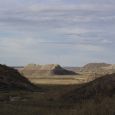
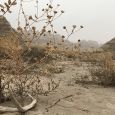
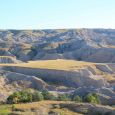
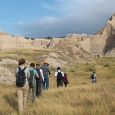
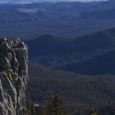
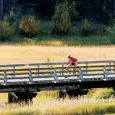


Comments